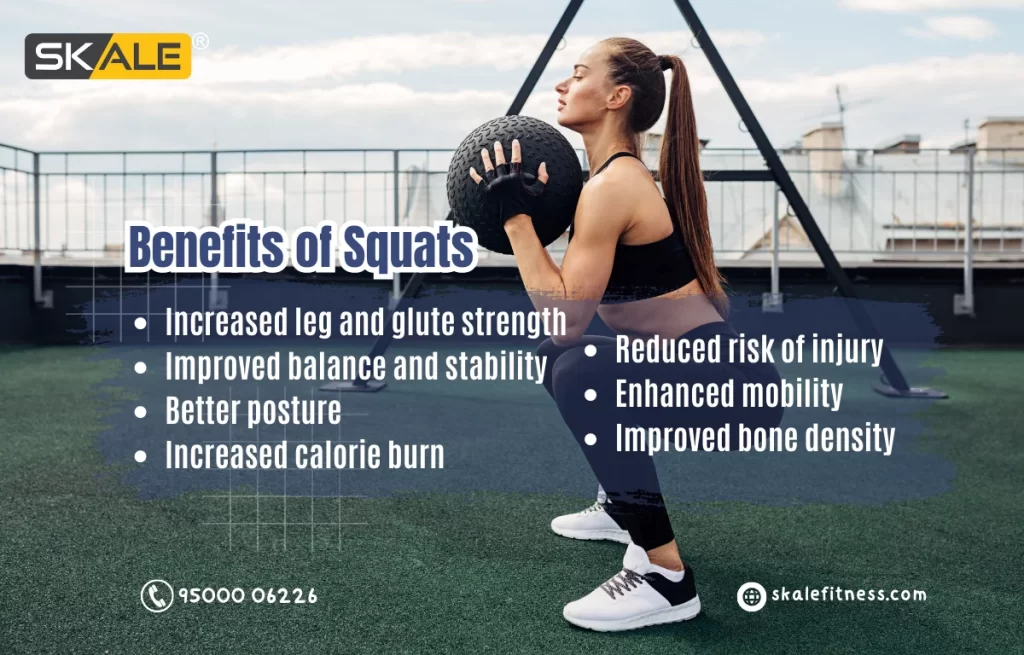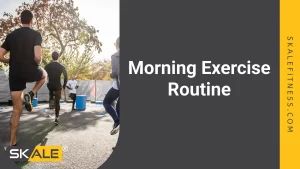Squats are a highly effective exercise for improving overall fitness and have been used for centuries as a means of building strength and power in the lower body. Whether you’re a beginner or an experienced athlete, incorporating the right way to squat into your workout routine can help you achieve your fitness goals and improve your overall health. In this blog, we’ll explore the benefits of squats, how to perform a basic squat, and tips for success.
Importance of Squats
Here are some reasons why squats are beneficial and why they hold such importance:
- Builds Lower Body Strength: By regularly performing squats, you can develop stronger and more defined leg muscles. This not only enhances your physical appearance but also improves your overall functional strengths.
- Increases Core Strength: Knowing the right way to squat engages the core muscles, including the abdominals, obliques, and lower back. Maintaining proper form during squats requires a stable and strong core. By strengthening your core muscles through squats, you improve your balance, stability, and overall body control.
- Enhances Mobility and Flexibility: Regularly performing squats helps to increase joint flexibility and improve mobility in these areas. This can be particularly beneficial for individuals who have sedentary lifestyles or spend long hours sitting.
- Burns Calories and Promotes Fat Loss: Squats are a compound exercise that engages multiple muscle groups simultaneously. This results in a higher caloric expenditure compared to isolated exercises. Squats also increase your heart rate, leading to cardiovascular benefits. It can aid in weight loss and overall fat loss.
- Functional Benefits: The mimic movements of performing the right way to squat strengthen the muscles, improve functional fitness, and make everyday activities easier and more efficient.

How to Perform a Basic Squat
Performing a basic squat is relatively simple, but it’s important to get the right way to squat, maximize the benefits and avoid injury. This is a step-by-step guide for performing a basic squat:
1. Stance and Foot Placement: Stand with your feet shoulder-width apart, facing forward.
2. Upper Body Position: Keep your chest up and your back straight.
3.Initiating the Movement: Begin by shifting your weight back into your heels.
4.Descending into the Squat: Slowly bend your knees, lowering your hips down and back as if you were sitting in a chair. Keep your knees aligned properly with your toes.
5.Rising from the Squat: Push through your heels to return to the starting position, keeping your back straight.
Common Mistakes to Avoid
When performing squats, it’s important to avoid common mistakes that can affect your form and reduce the effectiveness of the exercise. These are some of the most common mistakes to check:
- Knee Valgus: This occurs when your knees cave inwards as you lower into the squat. To avoid this, focus on keeping your knees aligned with your toes.
- Rounding the Lower Back: This can occur if you’re not using your core to maintain proper posture. To avoid this, keep your chest up and your back straight throughout the movement.
The Benefits of Squats
Squats are a highly versatile exercise that can be used to target several different muscle groups in the lower body. The right way to squat includes the quadriceps, hamstrings, glutes, and calves. By strengthening these muscles, squats can help improve your mobility, flexibility, and balance. Additionally, squats are a great calorie-burning exercise that can help you lose weight and tone your body.
Tips for Success
Incorporating the right way to squat into your workout routine can be a great way to achieve your fitness goals, but it’s important to start slowly and focus on proper form. Here are some tips for success:
- Begin with Bodyweight Squats: If you are a beginner to squats, start with bodyweight squats before adding weight. This right way to do squats will help you get the technique right before progressing to more advanced variations.
- Progress Slowly: Gradually increase the weight and difficulty of your squats as you get stronger.
- Focus on Proper Form: Always focus on maintaining proper form throughout the movement, even if you have to reduce the weight you’re using.
- Incorporate Squats into a Routine: Adding the right way to do squats to your workout routine at least once a week to start seeing results.
The Right Way to Squat
To perform a squat correctly, stand with feet shoulder-width apart, toes pointing slightly outward. Keep your chest up, engage your core, and lower your body by bending at the hips and knees. Ensure your knees don’t go past your toes, and lower until your thighs are parallel to the ground. Push through your heels to stand back up.
Conclusion
To sum up, squats are a highly effective exercise for improving overall fitness and have been used for centuries as a means of building strength and power in the lower body. By incorporating the right way to squat into your workout routine can help you achieve your fitness goals and improve your overall health. Just remember to start slowly, focus on proper form, and progress gradually to maximize the benefits of squats.
Also, Read Top 10 Fitness Centre and Gym in Chennai.





